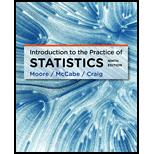
Concept explainers
(a)
The explanatory variable and response variable.
(a)
Answer to Problem 121E
Solution: “Age (years)” of the candidates is the explanatory variable and “Rejected (Yes/No)” is the response variable.
Explanation of Solution
In the study, there are two variables. One is an explanatory variable and the other is a response variable. An explanatory variable is a variable that affects the value of response variable and a response variable measures the result of the study. In the study, “Age (years)” is considered as the explanatory variable and the “Rejected (Yes/No)” is the response variable.
(b)
To find: The joint distribution.
(b)
Answer to Problem 121E
Solution: The joint distribution is provided below:
Explanation of Solution
Calculation: The joint distribution is computed by dividing the cell element by the total observation. The obtained joint distribution for under 20 can be calculated as follows:
Similarly, for other age group, the joint distribution can be calculated by using the above formula.
The joint distribution of the rejection data for the candidates classified by age is provided below:
From the table above, each cell shows a probability. For each cell, proportion is computed by dividing the cell entry by the total sample size. The collection of these proportions is the joint distribution of the two categorical variables. Because this is a distribution, the sum of the proportion should be 1. For this, the sum is 0.9999 that is approximately equal to 1.
(c)
To find: The two marginal distributions.
(c)
Answer to Problem 121E
Solution: The marginal distribution of “Rejected” is given below:
Marginal distribution of “Rejected” |
|
Yes |
No |
The marginal distribution of “Age” is given below:
Marginal distribution of “Age” |
|||||
Under 20 |
20 |
25 |
30 |
35 |
Over 40 |
Explanation of Solution
Calculation: Now, the marginal distribution is computed by dividing the row or column totals by the overall total. The marginal distribution of “Rejected” is given below:
Marginal distribution of “Rejected” |
|
Yes |
No |
The marginal distribution of “Age” is given below:
Marginal distribution of “Age” |
|||||
Under 20 |
20–25 |
25–30 |
30–35 |
35–40 |
Over 40 |
It is clearer to present these distributions as percent of the table total. The marginal distribution of the “Rejection” and “Age” is provided below:
Marginal distribution of “Rejected” |
|
Yes |
No |
3% |
97% |
Marginal distribution of “Age” |
|||||
Under 20 |
20–25 |
25–30 |
30–35 |
35–40 |
Over 40 |
17.63% |
23.52% |
16.96% |
13.69% |
15.09% |
13.30% |
Interpretation: This distribution does not provide any information about the relationship between the variables. The sum of the proportion should be 1.
(d)
The conditional distribution that will give the better explanation between the variables.
(d)
Answer to Problem 121E
Solution: The conditional distribution of “Rejection given Age” will give the better explanation between the variables.
Explanation of Solution
(e)
To find: The conditional distribution.
(e)
Answer to Problem 121E
Solution: The conditional distribution is provided below:
Explanation of Solution
Calculation: The conditional distribution is obtained by dividing the row or column elements by the sum of that row or column observation. The conditional distribution of “Rejection” for given age can be calculated as follows:
Similarly, the conditional distribution for the others can be calculated by using the above formula.
The conditional distribution of “Rejection for given age” is provided below:
Interpretation: When the value of one variable is conditioned in calculating the distribution of the other variable, we obtain a conditional distribution. From the above table, as the age increases, the number of rejected candidates also increases. This happens due to weak teeth in the older age.
Want to see more full solutions like this?
Chapter 2 Solutions
Introduction to the Practice of Statistics
 MATLAB: An Introduction with ApplicationsStatisticsISBN:9781119256830Author:Amos GilatPublisher:John Wiley & Sons Inc
MATLAB: An Introduction with ApplicationsStatisticsISBN:9781119256830Author:Amos GilatPublisher:John Wiley & Sons Inc Probability and Statistics for Engineering and th...StatisticsISBN:9781305251809Author:Jay L. DevorePublisher:Cengage Learning
Probability and Statistics for Engineering and th...StatisticsISBN:9781305251809Author:Jay L. DevorePublisher:Cengage Learning Statistics for The Behavioral Sciences (MindTap C...StatisticsISBN:9781305504912Author:Frederick J Gravetter, Larry B. WallnauPublisher:Cengage Learning
Statistics for The Behavioral Sciences (MindTap C...StatisticsISBN:9781305504912Author:Frederick J Gravetter, Larry B. WallnauPublisher:Cengage Learning Elementary Statistics: Picturing the World (7th E...StatisticsISBN:9780134683416Author:Ron Larson, Betsy FarberPublisher:PEARSON
Elementary Statistics: Picturing the World (7th E...StatisticsISBN:9780134683416Author:Ron Larson, Betsy FarberPublisher:PEARSON The Basic Practice of StatisticsStatisticsISBN:9781319042578Author:David S. Moore, William I. Notz, Michael A. FlignerPublisher:W. H. Freeman
The Basic Practice of StatisticsStatisticsISBN:9781319042578Author:David S. Moore, William I. Notz, Michael A. FlignerPublisher:W. H. Freeman Introduction to the Practice of StatisticsStatisticsISBN:9781319013387Author:David S. Moore, George P. McCabe, Bruce A. CraigPublisher:W. H. Freeman
Introduction to the Practice of StatisticsStatisticsISBN:9781319013387Author:David S. Moore, George P. McCabe, Bruce A. CraigPublisher:W. H. Freeman





